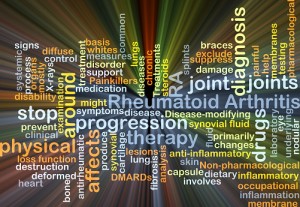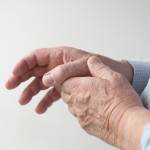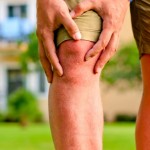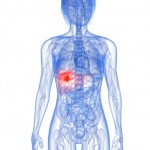Rheumatoid arthritis breakthrough: Gene regulating severity of tissue damage identified
 Recently, there was a scientific breakthrough on the diagnosis of rheumatoid arthritis (RA); a team of researches uncovered a protein that helps regulate the severity of tissue damage caused by RA. This discovery is going to provide a quicker and earlier diagnosis for patients who would experience the most severe effects of rheumatoid arthritis. Early diagnosis will lead to aggressive treatments and as a result, reduced damage to the joints.
Recently, there was a scientific breakthrough on the diagnosis of rheumatoid arthritis (RA); a team of researches uncovered a protein that helps regulate the severity of tissue damage caused by RA. This discovery is going to provide a quicker and earlier diagnosis for patients who would experience the most severe effects of rheumatoid arthritis. Early diagnosis will lead to aggressive treatments and as a result, reduced damage to the joints.
Currently, one of the major challenges of RA is effectively diagnosing it early enough to treat it. A team of Irish scientists from UCD and the University of Sheffield analyzed biopsy samples and DNA data from over 1,000 RA patients.
Research leader, from UCD, Professor Gerry Wilson, said, “Our findings provide a genetic marker that could be used to identify those RA patients who require more aggressive treatments or personalized medicine.” The marker is a protein (C5orf30) that can help normalize the level of tissue damage (and even prevent tissue damage) resulting from RA.
Researchers are hoping to further study the effects of C5orf30 on RA patients.
Facts about rheumatoid arthritis
 Rheumatoid arthritis is an autoimmune disease. It causes pain, joint damage, stiffness and inflammation in the hands, feet, knees and hips. It commonly affects more than one joint at a time. It can also result in fever, fatigue and nausea. It effects women more often (and more severely) than men and is most common for those between the ages of 40 and 70. Unfortunately, it can also be found in children and young adults.
Rheumatoid arthritis is an autoimmune disease. It causes pain, joint damage, stiffness and inflammation in the hands, feet, knees and hips. It commonly affects more than one joint at a time. It can also result in fever, fatigue and nausea. It effects women more often (and more severely) than men and is most common for those between the ages of 40 and 70. Unfortunately, it can also be found in children and young adults.
Although there are mild and moderate cases of RA, most patients suffer from a severe form that lasts several years or even a lifetime. RA affects about one percent of the population and is the most common form of inflammatory arthritis. Thirty percent of rheumatoid arthritis patients will be incapable of working after only 10 years of suffering.
Rheumatoid arthritis is often debilitating and there is no cure; however, if it is caught early, aggressive treatment and self-regulation have been known to help reduce the overall pain. That is why the recent study has proved to be such a breakthrough for those suffering from RA.
Along with the breakthrough discovery of protein markers, there are many symptoms of rheumatoid arthritis. There are also risk factors that increase your chance of developing RA.
Symptoms and risk factors of rheumatoid arthritis
 At the start of RA, smaller joints are most often affected, especially your knuckles. Next, symptoms can spread to other areas of the body, such as ankles, wrists, elbows, hips, knees and shoulders. If you experience the pain in your left knee, you will most likely experience it in your right knee as well. Some symptoms of rheumatoid arthritis are frequent and severe while others tend to come and go in waves. As time passes, RA causes deformation and shifting of joints which is quite painful for the individual suffering from it.
At the start of RA, smaller joints are most often affected, especially your knuckles. Next, symptoms can spread to other areas of the body, such as ankles, wrists, elbows, hips, knees and shoulders. If you experience the pain in your left knee, you will most likely experience it in your right knee as well. Some symptoms of rheumatoid arthritis are frequent and severe while others tend to come and go in waves. As time passes, RA causes deformation and shifting of joints which is quite painful for the individual suffering from it.
If any of the following symptoms persist, you should make an appointment to see your doctor:
- Swollen joints that often feel warm and tender
- Stiffness – usually in the morning and can last for many hours
- Rheumatoid nodules – firm lumps of tissue found under the skin on your arms
- Fatigue – often accompanied by fever and weight loss
If you are concerned about developing this severe form of arthritis, there are a few factors which can contribute to the risk of rheumatoid arthritis, including:
- Gender – women are more susceptible to the development of rheumatoid arthritis
- Family history – if someone in your family suffers from RA, your chances of developing the disease increase
- Age – although it can affect anyone at any age, it usually occurs between the ages of 40 and 70
- Environment – certain activities or lifestyle choices can lead to RA
Unfortunately, once you start showing symptoms of rheumatoid arthritis you will also be experiencing the accompanying pain. It is useful to be aware of the other effects of RA on the body.
Effects of rheumatoid arthritis on the body
 According to the Arthritis Foundation, over 1.5 million people in the U.S. suffer from RA. Although rheumatoid arthritis mainly effects the joints, it can also cause symptoms through the entire body. The symptoms of RA effect the following:
According to the Arthritis Foundation, over 1.5 million people in the U.S. suffer from RA. Although rheumatoid arthritis mainly effects the joints, it can also cause symptoms through the entire body. The symptoms of RA effect the following:
- Skeletal system – inflammation of the smaller joints in your hands and feet are often the first sign of rheumatoid arthritis. The pain is most pronounced in the morning and also includes swelling, tenderness, stiffness and even tingling or burning sensations.
- Circulatory system – rheumatoid arthritis can affect the creation and transportation of blood throughout your body. It also increases the risk of anemia, blocked or hardened arteries, rheumatoid vasculitis (inflamed blood vessels) and even lead to congestive heart failure.
- Respiratory system – rheumatoid arthritis increases the risk of inflammation, scarring and damage to the lungs and lung tissue. It can also block airways, increase blood pressure in the lungs and lead to fluid in the chest. It can cause chest paints, shortness of breath and coughing.
- Eyes, skin and mouth – RA can cause rheumatoid nodules under the skin. RA is often accompanied by Sjogren’s syndrome which can cause dry eyes and the increased risk of infection or corneal damage. Sjogren’s can also lead to chronic dry mouth and swollen glands making it more difficult to eat or swallow.
- Immune system – Because rheumatoid arthritis is an autoimmune disorder, the joints are under attack from the immune system, causing chronic inflammation through the body.
- Overall health – Along with all the symptoms above, RA can cause fatigue, sleep deprivation, fever, lack of appetite, an inability to regularly exercise (which also leads to additional health problems) and a decrease in energy levels.
If you are suffering from RA and want to help reduce the symptoms there are several measures you can take to prevent joint damage and severe pain.
5 tips to prevent joint damage caused by rheumatoid arthritis
 Although there is no cure for rheumatoid arthritis, treatment for has improved. Following a few simple steps can help most people experience less joint damage than in the past. Here are five tips to help improve your chances of decreased pain and damage:
Although there is no cure for rheumatoid arthritis, treatment for has improved. Following a few simple steps can help most people experience less joint damage than in the past. Here are five tips to help improve your chances of decreased pain and damage:
- 1. Early treatment – serious damage can start right after RA begins, so earlier treatment can reduce the odds.
- 2. Visit your doctor – frequent visits to your doctor (rheumatologist) can reduce the damage caused by RA.
- 3. Regular exercise – it can be painful, but an exercise plan created by your physical therapist or doctor can help make the joints stronger and more resistant to damage.
- 4. Rest – be sure to find a good balance between exercise and resting so you don’t overdo it and injure yourself further.
- 5. Use a walking aid – a cane or walker can help reduce the everyday wear-and-tear on your affected hip or knee.
Unfortunately, there is no current cure for rheumatoid arthritis; however, the new research can help provide earlier detection which will lead to faster treatment and reduced severity in symptoms. Be aware of your risk factors and the symptoms of RA and be sure to contact your healthcare professional if any pain is persistent or overwhelming.
Related reading:
Should you exercise if you have arthritis?
If we have an underlying health condition, like arthritis, exercise may be difficult and almost scary. No matter the benefits, if we think exercising will increase our pain, it’s likely we’ll avoid it. Here’s what you need to know about staying active with arthritis. Continue reading…
Mood affects pain in rheumatoid arthritis patients
The study uncovered that positive mood was associated with less pain and fewer arthritis-related restrictions, and negative mood increased pain and arthritis-related restrictions. Continue reading…
-
DASH (High-Plant) Diet for Heart Health, Weight Loss and Diabetes Prevention/Control
Reports from Harvard School of Public Health shows that a diet rich
-
Weight Loss Diet - Six Weight Loss Diet Tips
Everyone knows that most people would li
-
Learn All About Weight Loss With These Tips
There was once a very wise man who stated that good things come
-
Getting Through The Holidays Without Gaining Weight
Now that the holiday season is here, holiday foods and meals take cent
-
The Food You Should Avoid If You Have Diabetes
Foods to prevent for diabetes specially refer to persons which act
-
6 Ways To Maintain A Healthy Weight For Life
There is a persistent misconception that diets are the way to go regar
- DON'T MISS
- How to get rid of Fat Handles
- Phentermine Pills
- Discover The Missing Link In Weight Loss
- Slim Chews Natural Weight Loss Program
- Weight loss Conditioning and Nutrition for Long Term Success
- 5 Easy Ways to Boost Your Metabolism
- The Real Mayo Clinic Diet
- Is Water fasting for weight loss going to be assisting you to drop some pounds
- Changing Your Life One Workout at a Time
- Losing Weight By Eating Low Carbohydrate Foods




